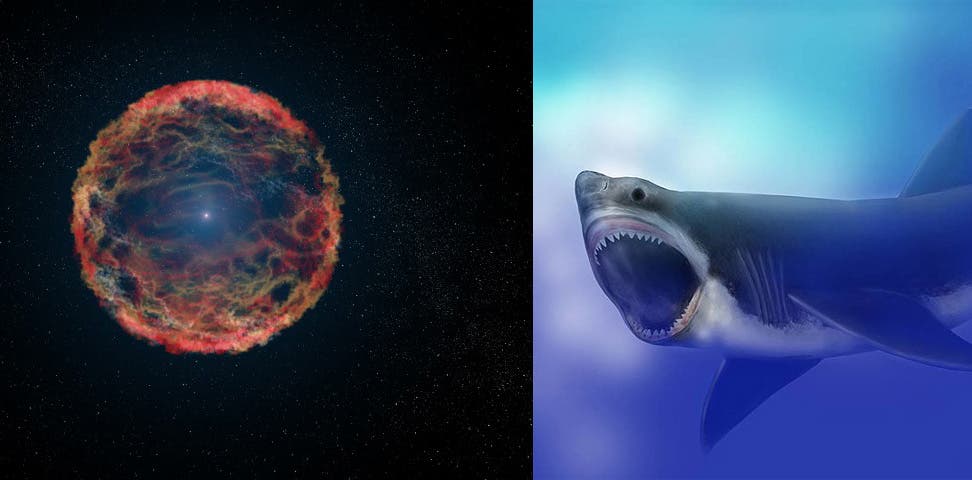
About 2.6 million years ago, nearly a third of the world’s large marine species mysteriously disappeared from the world’s oceans. Among them were huge apex predators, such as Carcharocles megalodon, which ruled the seas for over 20 million years. Climate change played an important role in the demise of Megalodon and other creatures like it, but it alone doesn’t seem to explain the magnitude of the Pliocene marine megafauna extinction. Now, a new study suggests that the extinction event may have a cosmic origin — a supernova, or possibly a string of supernovae, may have bombarded the oceans with radiation that decimated the largest marine creatures.
Death from above
In a new study led by Adrian Melott, professor emeritus of physics and astronomy at the University of Kansas, researchers describe evidence of nearby supernovae, whose explosion coincided with the onset of the Pliocene megafauna die-off.
When a star is ready to drop the curtain, it goes out with a bang — a titanic explosion known as a supernova. Although it might sound dramatic, these highly energetic events are quintessential to seeding new stars and solar systems, as they expel and distribute matter throughout the universe. Thus, understanding supernovae is key to demystifying the grander astronomic picture — how the cosmos evolves and how we all came to be.
Supernovae can also be destructive if something happens to cross their path. Melott and colleagues claim that a series of such explosions occurred between 8.7 million and 1.7 million years ago, at about 325 light-years from Earth. That’s far away enough not to cause catastrophic damage but close enough to bombard Earth with cosmic radiation. And this radiation may have been powerful enough to triggered mutations that led to cancer among Earth’s megafauna. The larger an animal was during such conditions, the more radiation it would absorb, thereby making them more vulnerable to the supernova-sourced radiation. The researchers estimate that the cancer rate would have gone up by about 50% for something the size of a human, but it would have been much worse for something as big as an elephant or whale.
“I’ve been doing research like this for about 15 years, and always in the past it’s been based on what we know generally about the universe — that these supernovae should have affected Earth at some time or another,” said Melott, in a statement. “This time, it’s different. We have evidence of nearby events at a specific time. We know about how far away they were, so we can actually compute how that would have affected the Earth and compare it to what we know about what happened at that time — it’s much more specific.”
Scientists know that such supernovae have occurred and pointed towards Earth due to iron-60 isotopes that have been engraved on the seafloor. These isotopes have a half-life of about 2.6 million years, so if they formed with the Earth, they would have been long gone. But instead, such isotopes can still be found in sediments drilled from the bottom of the seas and oceans. This can only mean evidence of radiation bombardment from one or multiple supernova events.
Specifically, muons may have been the culprit for the Pliocene marine extinction. The muon is an elementary subatomic particle similar to the electron but 207 times heavier. Muons are all around us, the products of cosmic radiation interacting with the atmosphere. However, the supernova radiation may have triggered extra muon exposure — much more than life can normally tolerate.
“The best description of a muon would be a very heavy electron — but a muon is a couple hundred times more massive than an electron,” Melott said. “They’re very penetrating. Even normally, there are lots of them passing through us. Nearly all of them pass through harmlessly, yet about one-fifth of our radiation dose comes by muons. But when this wave of cosmic rays hits, multiply those muons by a few hundred. Only a small faction of them will interact in any way, but when the number is so large and their energy so high, you get increased mutations and cancer — these would be the main biological effects. We estimated the cancer rate would go up about 50 percent for something the size of a human — and the bigger you are, the worse it is. For an elephant or a whale, the radiation dose goes way up.”
But if that were the case, why didn’t land animals go extinct at a similar rate? Radiation from the sun and the cosmos typically can’t penetrate more than a couple of feet of water, thereby shielding marine life. However, the shielding doesn’t work for muons. Suddenly, creatures that had adapted to a low-radiation environment for millions of years become exposed to a lot of it. Land animals, on the other hand, were adapted to radiation exposure and weren’t as affected as marine life.
And as if supernova radiation wasn’t scary enough. Around the same time, 2.6 million years ago, the planet’s magnetic poles reversed, which opened the floodgates for muon bombardment. The final nail in the coffin was climate change — around the same time a new Ice Age started, greatly diminishing coastal food supplies.
All of these factors form a complex, but a plausible picture that may explain the extinction of Earth’s marine giants.
“There really hasn’t been any good explanation for the marine megafaunal extinction,” Melott said. “This could be one. It’s this paradigm change — we know something happened and when it happened, so for the first time we can really dig in and look for things in a definite way. We now can get really definite about what the effects of radiation would be in a way that wasn’t possible before.”
You can read the entire study here.






